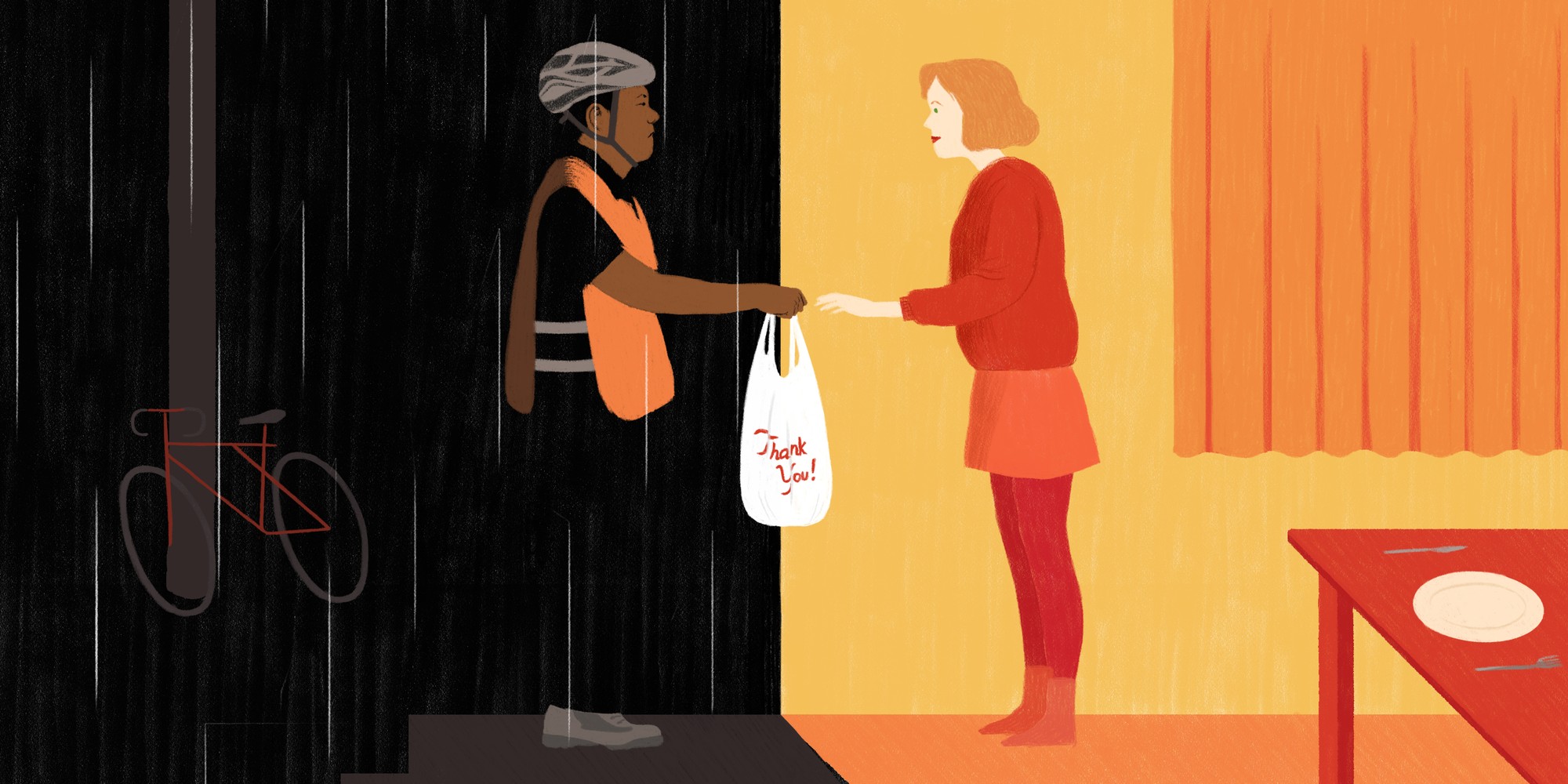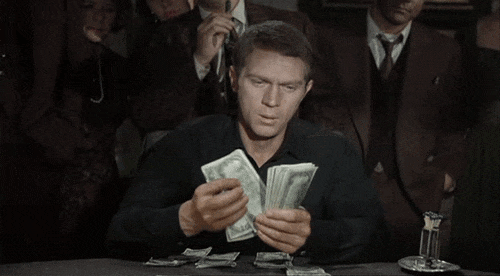It’s 2016 in New York City, which means you can get just about any edible you want deposited directly to your doorstep. Take-out, groceries, booze, weed: you name it, someone delivers it. New Yorkers already cook less and eat out more than any of their fellow Americans, but now it’s easier than ever. Apps like Seamless, GrubHub, Yelp’s Eat24 and Delivery.com let you filter hundreds of menus based on location, cuisine, and price, while software companies like ChowNow and Olo process and track orders straight from the restaurant’s website.
Online food delivery options are multiplying like freelancers in Bushwick and just about everyone’s taking a stab at it: chef David Chang’s new delivery site, Ando , currently exclusive to Midtown East, is already waitlisted. This summer, the New York Times will partner with Chef’d to roll out meal kits paired with NYT Cooking recipes. Amazon and Google are using their god-like search engines to feed shoppers with a single click, while UberRUSH uses its growing fleet of drivers and bikers to deliver for ChowNow , UberEATS and others, like Ando. This is all great, right? Delicious food you order from a sexy app gets magically delivered to your home, work, or wherever you are. The clever marketing behind this growing empire of app-based delivery enables you, bold eater, to #SkipTheLine ! It reassures you this is easier than eating itself.
But until drones fly above Midtown traffic carrying our pad kee mao and guac-loaded burritos to our desks, every delivery still relies on a real human being to bring us the goods. And they need to earn a living, just like us.
Too often, the foundational elements of online food delivery—the labor of food prep and the trek getting it into your mouth—remain invisible at best and exploited at worst. Amidst all of this tasty tech innovation and marketing, there’s hardly any mention of who bridges the gap between the food app and the front door: the delivery people who brave the traffic, weather, and potholes to bring us our food.
Delivery is no joke. According to the 2014 Bureau of Labor Statistics report , the transportation industry accounts for 40 percent of all fatal occupational injuries, making it the second most dangerous occupation (construction ranks #1). Service providers, including delivery drivers, account for nearly half of these transportation deaths. In NYC, bicycle delivery is a fast, cheap form of transportation that is steadily growing , but it’s also the most dangerous. A 2015 report based on traffic data from NYC’s OpenData portal revealed that 77.5 percent of bicycle crashes resulted in an injury , and recent years have seen NYC cyclist deaths increase despite efforts to improve safety. It’s difficult to estimate how many of these injuries are related to your extra large pepperoni pizza or box of online groceries, but chances are it’s higher than you think given the rise of urban delivery services catering to way more than food, like Zipments, TaskRabbit, and Postmates.
 Your delivery person doesn’t always have much to smile about. Illustration by Laura Lannes
Your delivery person doesn’t always have much to smile about. Illustration by Laura Lannes
Your last take-out delivery guy probably resembled Gabriel Martinez Rios more than Chop Chop Courier Group ‘s young, neck-tattooed messengers on pastel-colored fixies. Rios, 38, attached a GoPro camera onto his bike helmet for a Huffington Post story, to show what a day of deliveries in Murray Hill is like. The footage is condensed into a 2 minute video, “A Day in the Life of a Seamless Delivery Guy” and highlights some of the daily risks on the job: rampant bicycle theft, reckless cab drivers, and harsh weather conditions, not to mention low hourly wages, $1 tips, and long commutes home. Rios works 7 days a week between 2 restaurants, and uses his own smartphone (and data plan!) to receive and deliver the orders. Rios’s story is similar to 40-yr old Sunset Park resident Lin Dakang. The New York Times followed Dakang around the Upper East Side documenting how, for immigrant men struggling to make ends meet by delivering food, “their world draws little notice from most New Yorkers.”
Crain’s New York recently discussed the high-stakes job of bike messengers, in which a growing demand for contracted labor leaves new couriers uninsured and untrained—often without reflective vests or protective helmets—as they weave in and out of NYC traffic with an armload of goods. Workers’ compensation policies don’t require businesses to provide insurance coverage for independent contractors, so if the delivery person gets hurt on the job (be it via bike crash, traffic collision, or mugging), third-party apps like UberRUSH don’t have to pay for it. According to Crain’s, this allows them to offer a much cheaper rate than local courier services like Chop Chop and Samurai Messenger, who absorb the added costs of insurance premiums, training, and hourly wages for their employees.
 The gulf between your food app and the food itself is greater than you might think. Illustration by Laura Lannes
The gulf between your food app and the food itself is greater than you might think. Illustration by Laura Lannes
Food-delivery giants may claim to support delivery drivers and applaud them as ” true heroes ” out on the streets, but accusations of exploitation are frequents: a lawsuit against Yelp began last year over tipped wage theft on their EAT24 app, and the GrubHub-Seamless merger in 2013 wasn’t without controversy . An investigation by the New York Attorney General’s office revealed that Seamless had a longstanding billing structure that allowed it to take hefty commission fees (ranging from 10-20%) from restaurant totals that included the tax and tip. This meant Seamless was essentially profiting from the tipped earnings of delivery drivers barely making the minimum hourly wage. A year after the investigation began, the Attorney General’s office announced that GrubHub had agreed to implement state law into its contracts. Now, GrubHub collects restaurant fees before taxes and tips, and must explicitly inform restaurants of their legal obligation to remit 100% of tips to delivery employees.
For restaurants already running on slim margins (and that’s basically all of them), the commission fee can feel massive. Restaurants choose a set percentage to pay GrubHub from orders processed through the app or website, a GrubHub salesperson confirmed, but there’s a big catch, says a Tribeca Citizen report . The higher the commission’s percentage, the higher the restaurant will appear in the search results, much like Google AdWords. This explains why you might see a food joint further away from you listed above one super close by: they’re paying a premium for a better ranking in the results.
Sure, restaurants could just leave the delivery app world if they don’t like it, but the food delivery game is too competitive—and with the higher prices for outsourcing online orders, there’s little extra income to pay delivery workers more.
Restaurant delivery workers in New York typically earn the tipped minimum wage of $7.50/hr plus tips, but some joints like Sage Brooklyn in Williamsburg and Peacefood Cafe in Manhattan say they pay more per hour for extra help in the kitchen when delivery orders are slow. According to the 2015 Bureau of Labor Statistics report, food delivery or sales workers earned an hourly mean wage of $9.98, amounting to $20,770 in annual income.
GrubHub’s CEO Matt Maloney writes frequent posts in GrubHub’s blog, The Tip Jar , about the current push to increase the minimum wage and abolish the tipping system. It seems progressive, but on closer inspection, if tipping is eliminated and incorporated into, say, the price of the food to offset the added cost of labor, GrubHub stands to make even more money on their commission rates as the cost of orders increases.

Take-out isn’t the only player in this game. Grocery and meal-kit apps whose brands have quickly become household names help you become a home chef, eat healthier, and virtually browse aisles of local produce without ever leaving your house. It’s easy to forget that yours isn’t the only labor going into your prix fixe meal. According to Glassdoor, warehouse and delivery employees at FreshDirect , BlueApron , and HelloFresh start out around $11/hr or $22,000/yr. FreshDirect does allow cash and card tipping for its delivery drivers, but it only encourages tips when customers feel they received ” exceptional service. ” It’s unclear what exceptional service entails. In fact, there’s a lot of confusion around delivery tipping protocol in general.
Questions posed on Reddit , Chowhound , and Yelp reveal that consumers are incredibly confused about how to tip for delivery. Comments devolve into endless debates that unrealistically pit servers who toil away in stuffy restaurants against delivery drivers who, according to the comments, are perceived as chilling out, maxing, relaxing all cool when they’re not dropping off orders under cloudless blue skies.
GrubHub doesn’t just quell your late-night munchies—it tracks and publishes data from its 7 million users across its 8 online brands including Seamless. The data from GrubHub shows that New Yorkers tip an average of 13.1% (not including cash tips) on delivery, while the national average is 13.9%—a far cry from the 19.3 percent national average for dining-in restaurant tipping from Zagat .
Food delivery tipping etiquette should be straight-forward, yet many remain in the dark because they’re unfamiliar with the food service industry or they’re convinced that their comfort is priceless. Does supporting a more ethical food system mean you should delete Seamless and cook every meal from scratch? Hell, no. But it’s important to think beyond the consumer-focused marketing of delivery apps and online ordering—there’s more involved than your growling stomach.
Here are some best practices for navigating an otherwise dark and murky system:
1. 18% to 20% of your bill is a standard tip, with a $4 minimum (whichever is higher). For other delivery services (think boxed groceries, meal-kits, booze, etc…) a standard tip is $3 minimum. Always tip more in bad weather .
2. Always, always, ALWAYS tip your delivery person, even if your groceries got jostled or your order was late. Keep a stash of cash on hand for this or tip upfront with a card when you must. You don’t know the cause of your late order or cold meal, but now you can imagine what they endured in getting it to you (let’s start with your 5 story walk-up).
3. Cash is greatly preferred (note on your order if you’re giving cash instead of leaving a bunch of sad zeros where a tip should be).
4. A hearty “Thank you!” is mandatory.
5. If you want to cut corners and save money, order for pick-up.
6. When ordering delivery, place your order by phone or on the restaurant’s website before heading to Seamless. If you can, choose the former and save them a few bucks.
7. Ask Questions! Chat with your delivery drivers and bikers about their work, when possible. Call up your favorite eateries and ask them what their labor policies are. Out of the hundreds of places you can feed your face, let them know why you chose them, and why you care about fair wages for your fellow humans.
It’s easy to get disconnected from who’s doing the delivery. Sure, we don’t receive table service when we order in—but then again, we also don’t have to put on shoes and leave the apartment. Let’s not forget the value of that luxury.










